BOMBING OF UNITED NATIONS HEADQUARTERS IN IRAQ
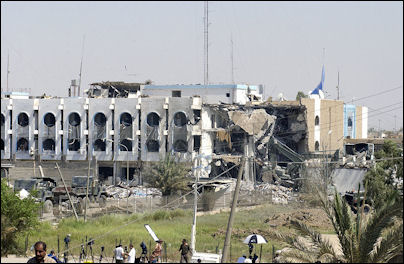
UN Headquarters in Iraq During the Iraq war, a group headed by the Jordanian Abu Musab Zarqawi, called Al-Qaida of Iraq, and other groups was responsible for a number of bombings, brutal acts and attacks in Iraq. Sometimes the targets were linked to Americans and Western interests. Other times the targets were Shiite Muslims. The objectives of some of these attacks, some believe, was to trigger civil war between Sunnis and Shiites.
In mid August 2003, a cement truck packed with explosives and driven by a suicide bomber destroyed much the United Nations’s headquarters at the Canal Hotel in Baghdad, killing 23, including United Nations envoy Sergio Viera de Mello, and injuring more than 100. Human remains were found inside the truck, indicating it was a suicide bombing.
The truck was packed with 680 kilograms of high-grade explosives, which detonated other munitions, including Soviet-era artillery and mortar shells, which had been loaded into the truck. The explosion took place behind a newly-erected 3.6-meter-high concrete security wall about 15 meters outside of Viera de Mello’s offices and left behind a two-meter deep crater and shredded the facade of the Canal Hotel and left its roof hanging precariously off the side of the building. The truck appeared to have been deliberately placed in spot that would kill Viera de Mello, had been conducting a meeting at the time of the explosion. Viera de Mello survived the blast but was badly injured and trapped in the rubble and died three hours after the explosion, before he could be extricated. He. Many of the others who were killed or injured were members of his staff.
The attack sent a signal that the war in Iraq was far from over and a new phase — the terrorist phases — was just beginning. No one took responsibility for the attack but many believe that Al-Qaida at least played a part in some of the planning. Security at the building as relatively light. The United Nations had wanted it that way because the organization “did not want a large U.S. presence.” In September there was a second attack on the United Nations compound U.S. Secretary of State Colin Powell urged the United Nations Secretary to keep the United Nations in Iraq. The United Nations reduced it presence from 800 to 900 foreign staff before the August attack to about 50 in October.
Bombing of Red Cross Headquarters in Iraq
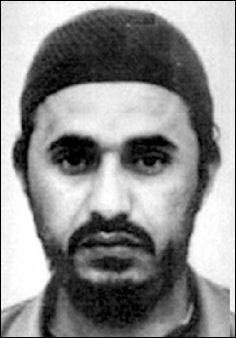
Zarqawi In October 2003, during the morning rush hour during the early days of Ramadan, suicide bombers set off powerful explosive outside the local Red Cross headquarters in Baghdad and three police stations, killing at least 40 people and wounding more than 230. Twelve people were killed and 10 were injured at the Red Cross headquarters. The others were killed at the Bayaa, Shaab and Khadra police stations in Baghdad.
The attack at the Red Cross headquarters was carried out with a vehicle resembling a Red Cross ambulance. The explosives were set off during rush hour and left behind a six-feet-deep crater in the pavement. Everyone was shocked that such an attack would be launched against the Red Cross, whose reputation of doing good had enabled it to operate in the most hostile places without it members being harmed. Red Cross members had been killed in Rwanda, Chechnya, Somalia and Afghanistan but no group had ever deliberately bombed a Red Cross facility before.
The Red Cross attack had all the hallmarks of an Al-Qaida attacks and showed that a series of coordinated attacks, involving dozens of people, could be organized and carried out in Iraq. The bombings were well coordinated and a diversionary tactic was used. The bombings all occurred within 45 minuets of each other. Each of the vehicles used in the attack was packed with at least 450 kilograms of plastic explosives. One the of bombers drove a car that looked like police car and wore a police uniform. In each case another lead vehicle was used to distract security guards guarding the entrance, allowing the explosive-packed vehicle to penetrate the perimeter. The attacker of one of the police stations was identified as a Syrian.
The attacks on the United Nations and Red Cross facilities marked the beginning of the targeting of foreign civilian targets by insurgents and terrorists rather than just military ones. The attacks also lead to the retreat of international aid agencies — even some of the most battle-hardened ones — from Iraq. At the time of the attack the Red Cross had 300 people in Iraq. It had reduced its staff from 1000 after a Sri Lanka Red Cross worker was killed in July 2003.
Bombing at Imam Ali Shrine

Car bomb in Iraq In August 2003, a suicide bomber blew up a car packed with several hundred kilograms of explosives in the middle of a large gathering at Najaf at Imam Ali shrine, Shiite Islam’s holiest shrine, killing at least 85 people, including the Ayatollah Mohammed Bakir al-Hakim, one of he most revered and highest ranking Shiite clerics in Iraq.
Hakim was clearly the main target. Such a large crowd had gathered because he was leading Friday prayers. The bomb was a device with 650 kilograms of explosives planted in a Kooa Pregio van, It used TNT to set off grenades, artillery and mortar shells. The van was parked right across the street from Hakim’s vehicle. The bomb went off just as he was getting into his car. He died instantly.
The attack was deadliest attack in Iraq up until that time and was one of the deadliest terrorist attacks ever. Al-Qaida was thought to be behind it. A number of men, many said to have Al-Qaida connections from Saudi Arabia, Jordan, Kuwait, Palestine and Iraq, were arrested by Iraqi police for their involvement in the attack. Materials used in the attack were the same as those used in the bombing of the United Nations Baghdad headquarters. Some blamed supporters of Saddam Hussein. Others said rival Shiite sects were behind it. Other still blamed Sunni insurgents. More than 300,000 marched by Hakim’s coffin during his funeral.
Account of the Bombing at Imam Ali Shrine
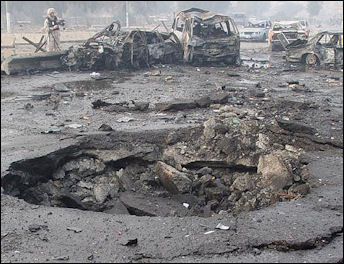
Car bombing Baghdad Aparisim Ghosh wrote in Time: “When the bomb went of shortly after 2 P.M., the narrow lane, crammed with people acted as a muffler. Just 300 yards away there was only a low boom...At the site of the explosion, the air was quickly filled with the sickly sweet odor of burning human flesh. The walls of the shrine saved thousands of worshippers inside, but those outside felt the full force of the blast. Charred victims were strewn across the narrow lane, some still alive, if only barely.”
“The injured ran and stumbled or crawled away, blood spouting from their wounds. A man leaning against a burning car, his clothes incinerated and strips of skin hanging from his elbows and knees...the flesh on his back had melted and fused to the car. He was ripped off the car, laid down on a jury-rigged stretcher...and hurried away by four men.”
“The bolts of fabric from a shop came in handy. By the time the first fire truck roared up, barely 10 minutes after the blast, at least a dozen shrouds had been fashioned from cloth. One of them made of polyester, caught an ember and began to blaze, blackening the body underneath. Two rescue workers turned away to throw up.”
Ashura Festival Attack in Iraq
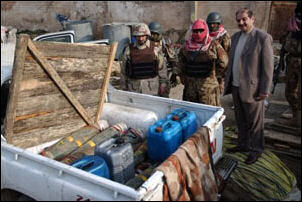
car bomb On March 2, 2004 around 180 people were killed in a series of attacks on pilgrims in the Iraq. The coordinated suicide attacks ripped through crowds of Shiite worshipers outside mosques in Baghdad and the holy city of Karbala during Ashura, one of the holiest events on the Shiite calendar. The attack was the deadliest since the fall of Saddam Hussein. There was some debate as to how many people were killed. U.S. officials put the figure at 117. The Iraqi Governing Council said 271 people were killed. Among the dead were 40 Iranians.
At least five bombs went off in Kabala. Over 100 were killed there. Another four were detonated around the Kadhimiya Mosque in Baghdad. One was detonate inside the main shrine, At least 75 are thought to have died there.
Many people in Karabla said the bombs were hidden in rubbish cans and they exploded as Iranian pilgrims were performing self- flagellation rituals. One witness told Reuters, “They were beating themselves and then I heard a big explosion from a cart near them. I turned and saw the carnage,” he said pointing to a mass of blood and body parts scattered on the road.
Account of the Ashura Festival Attack
![]()
injured bomb-tracking dog Justin Huggler wrote in the Independent: Just before the attacks the city was packed with a million Shia ...The streets were overflowing with vast crowds: bands of young men in black ritually beating themselves with chains...Packed in, the crowds had nowhere to escape...I was a 100 meters away from the first explosion....which sent a great yellow fire bellowing on the roof of Karbala... The first blast appears to have been from a suicide bomber, who detonated his explosives outside Karbala’s second shrine....That was just the first explosion, I counted eight more...some of the explosions that followed seem to have been mortar shells...Many fled one explosion only to be caught in the next.”
One survivor told the Independent, “Suddenly there was a huge fire in the street. I passed out. When I came around. I saw dead people all around...so many dead people. I saw pieces of flesh everywhere and heard screaming. When the ambulance came I jumped in.”
Describing the scene at one of the blasts in Karbala, Reuters reported: “Many corpses were missing body parts or deeply blackened and yellowed by the heat of the blasts...A man’s scalp and ear lay on the ground alongside rotting fruit and a muddied pool of water...terrified and sobbing, people ran through the streets with bodies laden two or three high onto wooden vegetable carts, desperately searching for a doctor or an ambulance.”
“Men broke up empty wooden crates to use as splints for broken limbs. One man, his hair brunt off and singed skin peeling from his face, sat staring ahead...Those who died were carried away in a rubbish truck, while ambulances took the most severely wounded to the local hospital.”
Bombings of Shiite Targets in 2004 and 2005
.jpg)
suicide bombing victim Shiite mosques, and funerals were frequent targets of Sunni-led insurgents. In December 2004, a car bomb exploded in Najaf during a funeral of a prominent sheik attended by thousands of people, killing 54 and wounding 142. On the same day a car bomb explosion at a bus station in Karbala killed 13 and injured 33. A few days earlier a bomb killed seven outside the Iman Hussein mosque in Karbala. Among the dead was a top aide of Ayatollah Ali al-Sistani. The aide was believed to have been the target of the attack.
Also in December 2004, a suicide car bomb exploded outside the headquarters of the SCIRI, Iraq’s largest Shiite political party, killing 13 people and injuring 50. Many think the target of the blast was party’s leader Abdul Aziz al-Hakim, the brother of assassinated Ayatollah Mohammed Bakir al-Hakim, Al-Zarqawi’s Al-Qaida of Iraq was believed to have been behind many of the attacks.
In January 2005,, a suicide car bomber detonated his vehicle outside a Shiite mosque in Baghdad as worshipers were leaving, killing 14 and wounding 40. In February 2005, suicide bombers attacked Shiite mosques in Baghdad during Ashura, killing 15 and injuring 42. In March 2005, a suicide bomber walked into a Shiite mosque in Mosul and blew himself up with a bomb strapped to his body among mourners who had gathered for a funeral, killing 40 people and injuring 60 more. In April 2005, a car bomb exploded at a Shiite mosque in Baghdad, killing eight people and wounding 20.
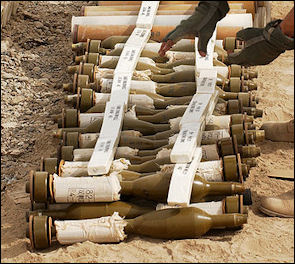
C4 bomb In July 2005, a suicide bombing involving an exploding fuel truck near a Shiite mosque in Musayyib, a highway town south of Baghdad in area described as the “triangle of death,” killed at least 70 and leaving more than 85 injured. Many of the dead were shopping in a busy vegetable market outside the mosque. The attacks was the most deadly of 15 suicide bombings within a 48 hour period. One man told Reuters, “After the bomb, I went over there and found my son’s head. I could not find his body.”
In September 2005, three suicide car bombers struck in the mostly Shiite town of Balad, just north of Baghdad, killing 99 people. Local people blamed foreign fighters from Palestine, Saudi Arabia and Jordan. In October a bomb exploded outside the entrance of Shiite mosque in Baghdad, killing 25 and wounding 87. In November 2005, a suicide car bomber detonated his explosives during a memorial service in Baqouba, 60 kilometers northeast of Baghdad, killing 36 Shiite mourners. A few days before a bomb exploded in truckload of dates in a farming village near Baqouba, killing 30 people. In October a suicide car bomb in predominately Shiite Basra left 20 dead.
Stampede Kills Almost 1,000 People
.jpg)
Baquba suicide bombing In August 2005, around 950 people were killed and more than 800 were injured in a stampede on a Tigris River bridge in Baghdad after rumors that a suicide bomber was about to blow himself up panicked a huge crowd that were heading to a religious ceremony.
Most of the dead were women and children who were trampled to death on the bridge or drowned after diving 9 meters from the bridge into the river. Huge piles of slippers remained on the bridge after the stampede. The Iraq Interior Ministry said 953 people were killed and 815 were injured. The Iraq Health Ministry said 843 people were killed and 439 were injured.
The disaster took place on the Imams Bridge during the annual commemoration of the death in 799 of Imam Moussa ibn Jaafar al-Kadhom, one of the 12 Shiite Imam, near a mosque dedicated to the Imam. One witness told Reuters that the crowd of ten thousand was heading to Kadhimiya Mosque in the old district of Baghdad when someone shouted there was a suicide bomber among them. “Hundreds of people started running, and some threw themselves off the bridge into the river. Many elderly died immediately as a result of the stampede. But dozens drowned, many bodies are still in the river and boats are working on picking them up.”
Attack on Madrid Commuter Trains in March 2004
Estacion El Pozo On March 11, 2004 four commuter trains in and around Madrid were hit by explosions that killed 191 people and injured around 1,800 during morning rush hour in an attack authorities said was inspired by Al Qaida. Some think one reason why Madrid was selected as a target was that Osama bin Laden seemed obsessed with expulsion of the Muslims from Spain in the 15th century. More believe it was motivated to get Spain to withdraw from the Iraq — an objective that was achieved. The attack led to the fall of U.S.-friendly government in a national election and one of the first things the new government did was pull Spain’s troops out of Iraq.
According to BBC report filed the day of the attack: Near simultaneous blasts hit Atocha station in the centre of the Spanish capital and two smaller stations, Santa Eugenia and El Pozo. Early reports say that two bombs exploded on one intercity train as it pulled into Atocha station at 0730 local time. Blasts were also believed to have taken place on two suburban trains on the rail line leading into the station. The government said there were four explosions altogether.
Juani Fernandez, 50, who was on a platform waiting for a train, told the BBC: "People started to scream and run, some bumping into each other. I saw people with blood pouring from them, people on the ground." Paramedics have set up an emergency field hospital outside Atocha, which is a major railway station used by commuter, intercity and subway trains.
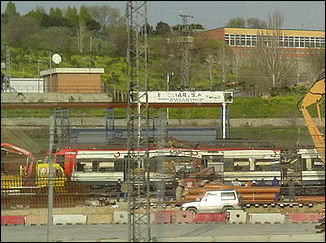
Madrid rescue services official Cesar Gomez said there was "a multitude" of injured at the station. Emergency services are trying to rescue commuters trapped on the trains. Hospitals in the city have appealed for people to come forward to give blood. A vast morgue has been set up in an exhibition hall and busloads of relatives are arriving to try to identify remains. Authorities have warned it is almost impossible to match body parts.
All trains in and out of the Spanish capital have been cancelled. Spain's national telephone operator, Telefonica, has urged people to send text messages instead of making calls to take the pressure off the network, which has collapsed.
No group has admitted carrying out the attacks but the Spanish government blames Basque separatist group ETA for the bombings, which come three days ahead of Spain's general election. Campaigning for the election has been suspended for the time being. The leader of one outlawed Basque party linked to ETA denied the Madrid bombings were the work of the separatist group. He suggested "Arab resistance" elements could be behind the attacks.Some experts on ETA said the bombings did not fit the group's usual profile for attacks. ETA have frequently phoned warnings ahead of attacks in the past. Police are reported to be hunting for two men seen jumping on and off trains further down the line from the sites where the explosions happened.
Events After the Attack on Madrid Commuter Trains
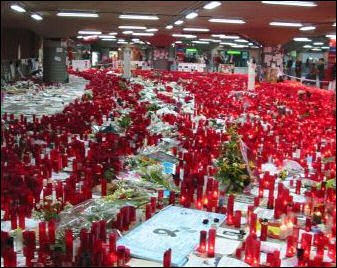
Atocha Station makeshift shrine AP reported: Hours after the attack “police found a van with detonators and a cassette tape with verses from the Qur'an at a train station through which all of the trains had passed. The next day Police deactivated a bomb hidden in a backpack found on one train. The mobile phone rigged as a detonator — a system also used in the other devices — was their first big break. [Source: Associated Press, guardian.co.uk, October 31, 2007]
On March 14, three days after the attack, “Socialists unseated the ruling conservatives in the scheduled general election. The conservatives had blamed the attacks on the armed Basque separatist group ETA, even as evidence of Islamic involvement emerged. Weeks later, the prime minister, José Luis Rodríguez Zapatero, withdraws Spanish troops from Iraq.
On March 13 “police made their first arrests, including a Moroccan-born man who sold the pre-paid cards used in the mobile phone-detonators. On March 26 police found detonators, traces of dynamite and fingerprints inside a rural cottage where police suspect the bombs were made. On April 3 seven suspects in the bombings blew themselves up as police move in on an apartment outside Madrid. Police described the men as ringleaders. One suspect escaped but is eventually caught in Serbia. A special forces soldier died in the blast.
On April 11 2006, “twenty-nine people were indicted over the attacks: 15 Moroccans, nine Spaniards, two Syrians, one Egyptian, one Algerian and one Lebanese. Prosecutors sought jail terms of more than 38,000 years for each of the seven top suspects. The trial started on February 15 2007 at a heavily guarded courthouse in Madrid. Over five months of testimony, more than 300 witnesses and 70 experts took the stand. Prosecutors eventually dropped charges against one suspect, reducing the total to 28. They also changed the sentences sought for several suspects. In the end, they request 38,000-year terms for eight men accused as ringleaders, material participants or key accomplices. The trial ended on July 2.
Al-Qaida and the Madrid Commuter Train Plot
March 13 2004, two days after the attack, Al-Qaida in Europe claimed responsibility for the bombings in a video found near a Madrid mosque. In the video, an Arabic-speaking man with his face covered says the bombs were revenge for the Spanish troop presence in Iraq and Afghanistan.

Madrid
Dale Fuchs wrote in the New York Times: “The Islamic terrorists responsible for the Madrid train bombings financed their plot with sales of hashish and Ecstasy and drank holy water from Mecca in ritual "purification acts" before the attacks, the Spanish interior minister, Ángel Acebes, said. In a final news conference before the newly elected Socialist government takes office, Mr. Acebes described the March 11 terror attacks as a local, independently organized operation led by people with "connections to other fundamentalist groups in Europe and outside Europe. [Source: Dale Fuchs, New York Times, April 15, 2004]
Craig Whitlock wrote in the Washington Post: The cell responsible for the March 2004 train bombings in Madrid needed $80,000 to finance the plot, according to Spanish court documents. But they had access to more than $2.3 million worth of hashish and other illegal drugs that they could have sold to raise more money, the documents showed.” [Source: Craig Whitlock, Washington Post, August 24, 2008]
London Subway Attack in July 2005
On July 7, 2005 four British Muslim suicide bombers detonated devices on London's public transport system, killing 56 people as they destroyed underground trains and a double-decker bus. Britons refer to the tragedy as 7/7, a sort of link to 9/11.
Alan Cowell wrote in the New York Times: “Only one day after the British capital erupted in joy at winning the 2012 Olympic competition over such cities as Paris and New York, commuters packed in the city's subways - the Tube - were plunged into the city's perennial nightmare of a subterranean bloodbath. The city center was paralyzed. Police in yellow slickers sealed off streets. Bus services halted and the entire subway network closed down as rescue workers and paramedics went deep below ground to look for the dead and wounded. [Source: Alan Cowell, New York Times, July 7, 2005]

locations of July 7, 2005 London attack
“Above ground, an explosion tore open the roof of a No. 30 double-decker bus with such force that it threw debris 10 feet into the air. The blast was so powerful that, hours later, the police could not estimate the number of dead. The attack... coincided with the first full day of deliberations among the leaders of the world's most industrialized countries far to the north at the Gleneagles golf estate in Scotland. The tactics in the bombings - a coordinated strike against rush-hour transport systems - bore a close resemblance to the attack last year in Madrid that claimed 191 lives.
A group describing itself as affiliated with Al Qaeda took responsibility for the attack on an Arabic-language Web site but British police said they were unable to confirm the authenticity of the claim. The group called itself the Secret Al Qaeda Jihad Organization in Europe and said the attacks were to avenge British involvement in the wars in Afghanistan and Iraq.
Craig Whitlock wrote in the Washington Post: “The cell responsible for the July 7, 2005, transit bombings in London needed only about $15,000 to finance the entire conspiracy, including the cost of airfare to Pakistan to consult with al-Qaeda supervisors, according to official British government probes. One of the July 2005 suicide bombers, a 22-year-old part-time worker at a fish-and-chips shop, left an estate worth $240,000 after he blew up a subway train. Neither his family nor authorities have explained where he got the money. [Source: Craig Whitlock, Washington Post, August 24, 2008]
Details of the London Attack in July 2005
Alan Cowell wrote in the New York Times: “The bombings began on what seemed a normal, busy day in the rush-hour. According to a police chronology, the first came at Liverpool Street Station at 8:51 a.m. (3:51 Eastern time) when an explosion tore through a subway train 100 yards into the tunnel. Seven people died. The second was at 8:56 a.m. at King's Cross station, a hub that, like Liverpool Street, links the subway to overland trains bound for the north-east. The death toll was 21 people, the police said. Twenty-one minutes later, at 9:17 a.m., a third blast ripped through a train coming into the Edgware Road underground station, again 100 yards away from the platform inside the tunnel. Five died there. And 30 minutes later, at 9:47 a.m., the upper deck of a bus was bombed at the junction of Upper Woburn Place and Tavistock Square. "We estimate many casualties," the police said. [Source: Alan Cowell, New York Times, July 7, 2005]
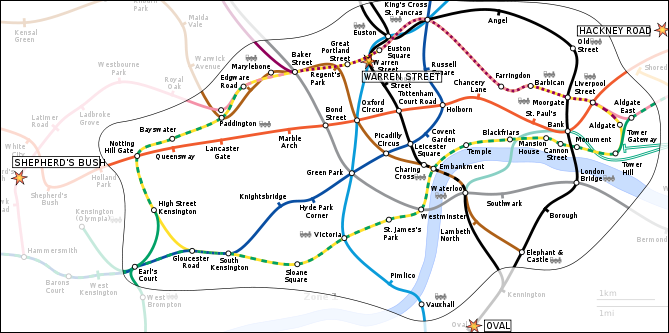
locations of July 21, 2005 London attack
“Tony Tindall, an Australian steel erector who has lived and worked in London for five years, heard the explosion on the bus and said: "The scene was just carnage. There was blood and guts everywhere." In a remarkable escape, Jasmine Gardner, 22 from Kent who works in television distribution, was about to board the No. 30 bus in Tavistock Square, having been forced off the subway by the earlier explosions. "I was trying to get on the bus," she said. "It was moving slowly though heavy traffic. The bus had stopped and let off most of its passengers. There were 15 to 20 people on board the number 30 bus. "One minute the bus was there, the next minute it seemed to dissolve into millions of pieces. I was showered with bits of metal and bits of the bus. I was shielding myself with my umbrella and it all landed on my umbrella. I completely broke down. I was stuck to the spot. I turned away because I couldn't face to look at it. Someone had to tell me to run away as fast as I could. It was horrific."
In total, the police said, more than 300 people were wounded, ferried to hospitals swathed in silvery space blankets, their faces blackened with soot. The police said seriously injured people had lost limbs and were badly burned. Since the Sept. 11 attacks police have been rehearsing emergency procedures and seemed to be following pre-arranged measures, urging people to stay where they were, tune into the television, radio or Web site and avoid central London. By evening some parts of the city were eerily calm, the usually thronged streets around some railroad stations cordoned off and empty, while thousands of people packed the sidewalks, seeking ways home.
Some Londoners took the bombings in stride, citing their long experience of attacks by the Irish Republican Army - but with the key distinction that the I.R.A. had often issued warnings of when it would strike. London's subway system, the world's oldest, transports three million people each day. Officials estimated that about 500 trains were in use at the time of the explosions, with some trains carrying as many as 900 people.
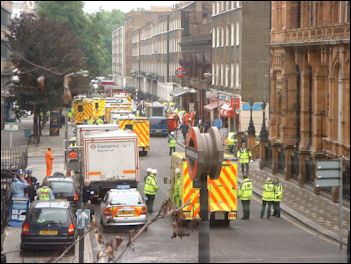
Russell Square July 7 The blast spread chaos with police cars, ambulances and fire engines speeding across the city.
Tourists lined the gates of Hyde Park, queuing to ask police officers how to reach the airport or other popular sites. Ten-minute tube rides became 45-minute walks. A woman eight months pregnant was told her trip home would take two hours. Around 11 a.m. along Edgware Road, pedestrians lined the police barriers, each seeking directions on how to get around the cordoned off areas.
Yusuf Pandor, 40, of North West London, was looking to return to his car on the other side of the barriers. A little more than an hour earlier, Mr. Pandor was one of many Samaritans helping pull bombing victims into the nearby Hilton Metropol. "They were shaken, bleeding," Mr. Pandor said. "One woman was badly injured burned on her face. She had it covered. People were just shocked." Loyita Worley, who works for a city law firm, told the BBC that she was in the subway when an explosion took place in the next carriage, while it was in a tunnel. Ms. Worley, 49, said: "All the lights went out and the train came to an immediate halt. There was smoke everywhere and everyone was coughing and choking, but remained calm. We couldn't open the doors."
Second London Terrorist Plot
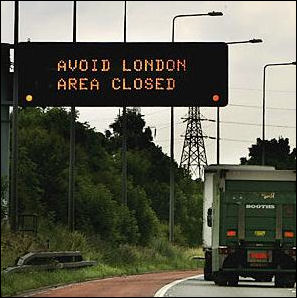
Two weeks after the London bombing that killed 56 people, four small explosions or attempted explosions temporarily shut down several London subway stations just after noon. According to The Daily Mail: “Police evacuated Shepherd's Bush Tube station on the Hammersmith and City line at 12:25pm following an attempt to set off an explosion. Around 20 or 30 passengers are evacuated from a Tube train saying that they had seen "white smoke". There are also reports of a man dumping a rucksack in a carriage then fleeing as the doors closed. [Source: Daily Mail]
At 12.45pm London Ambulance Service sent five vehicles to Warren Street Tube station after reports of a rucksack exploding on a train in a tunnel just outside the station. At 1.22pm London Underground said it had suspended services on the Hammersmith & City, Victoria and Northern lines. At 1.30pm the driver of the number 26 bus reported hearing a bang followed by a smell of smoke coming from the upper deck while driving along Hackney Road, Shoreditch. Upstairs he found the windows blown out.
At 1.45pm Transport for London confirmed it has imposed a Code Amber at all three affected Tube lines which means trains are taken to the next station and passengers evacuated to above ground. At 1.45pm police with sniffer dogs comb the pavement along Euston Road, near Warren Street and the surrounding area.
At 2.45pm Downing Street confirms the Government's civil contingencies committee - known as Cobra - would be meeting in response to the latest incidents. At 3.25pm London Fire Brigade said officers deployed at Warren Street London Underground station in full protective equipment as a precaution in order to examine the scene. At 4:00 pm armed police and dog handlers arrived at Shepherd's Bush to begin searches of streets that had earlier been sealed off. At 5.30pm Metropolitan Police Commissioner, Sir Ian Blair, said terrorists clearly "intended to kill", but said that there were no casualties taken to hospital. London Mayor Ken Livingstone said it "wasn't surprising" terrorists attempted to strike London again so soon after July 7 attacks.
London Subway Attack and Al-Qaida
Peter Bergen wrote in the Washington Post: The London attacks “have generally been portrayed as the work of four young British men of Pakistani and Jamaican descent from the north of England -- distinguished only by their utter ordinariness -- who embraced radical Islamist ideology and managed to carry out the deadliest terrorist attack on British soil in history without outside help. The Sunday Times of London even opined that "the new breed of unaffiliated terrorist is potentially far more dangerous than the IRA or even al Qaeda because he is almost impossible to identify." [Source: Peter Bergen, Washington Post, July 2, 2006]
“But the more you delve into the London bombings, the more they look like a classic al-Qaeda plot..."At a minimum, this was an al-Qaeda-supported operation," an analyst told me... The British government's official account of the attacks -- issued by the Home Office two months ago -- provides a revealing picture. It explains that the presumed ringleader, Mohammed Sidique Khan, visited Pakistan in 2003 and 2004, spending several months there. On one of those trips, he aimed "to cross the border and fight in Afghanistan," the report stated.
The report goes on to note that Khan "had some contact with al Qaida figures" in Pakistan, and is "believed to have had some relevant training in a remote part of Pakistan, close to the Afghan border" during his two-week visit in 2003. The British government did not specify what sort of training he received, but given that the London bombs were made of highly efficient explosives that can't be readily made from recipes on the Internet, it is probable that the training was in the manufacturing of bombs. According to the report, Khan was also in "suspicious" contact with individuals in Pakistan in the four months immediately before the London attacks. Taken together, Khan's travels and contacts in Pakistan strongly suggest an al-Qaeda role in the operation.
Khan also appeared on a videotape that aired on al-Jazeera two months after the suicide attacks -- an important fact to which the British report did not give sufficient weight. "I'm going to talk to you in a language that you understand," Khan said on the tape, speaking in the broad brogue of his native Yorkshire. "Our words are dead until we give them life with our blood." He goes on to describe bin Laden and Zawahiri as "today's heroes." Appearing on the same videotape, Zawahiri trumpeted al-Qaeda's responsibility for the London bombings. As a veteran U.S. counterterrorism official told me, "Zawahiri does not take credit for things that he hasn't done."
On the videotape, Zawahiri referenced a prior al-Qaeda threat to explain the targeting of London, saying "Didn't . . . Sheik Osama bin Laden offer you a truce?" -- a reference to the al-Qaeda leader's April 2004 proposal of a peace agreement with those European countries willing to pull out of Iraq. Britain is the most prominent member of that coalition. Bin Laden offered a three-month grace period before the truce expired in July 2004. A year later, the four bombers blew themselves up in London.
But the key piece of evidence overlooked in the British government report is that both Khan and Zawahiri's statements were made on a videotape bearing the distinctive logo of al-Sahab ("the clouds"), which is al-Qaeda's television production arm. Al-Sahab's first tape, a two-hour al-Qaeda infomercial, debuted on the Internet in the summer of 2001, signaling that a major anti-American attack was in the works. Since then, al-Sahab has continued to release key statements from al-Qaeda leaders. Khan's appearance on the videotape strongly suggests that he met up with members of al-Qaeda's media team based on the Afghan-Pakistan border, probably in the tribal area of Waziristan. There is much we still don't know about Khan's activities in Pakistan, but additional information is likely to point toward further contact with members of al-Qaeda in Pakistan.
Image Sources: Wikimedia Commons
Text Sources: New York Times, Washington Post, Los Angeles Times, Times of London, The Guardian, National Geographic, The New Yorker, Time, Newsweek, Reuters, AP, AFP, Wall Street Journal, The Atlantic Monthly, The Economist, Global Viewpoint (Christian Science Monitor), Foreign Policy, Wikipedia, BBC, CNN, NBC News, Fox News and various books and other publications.
Last updated July 2012

